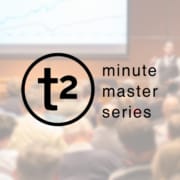Daily Minute Master Series – July 5, 2019
Marketing
Consumers indicate experience, not price, as top conversion factor
A recent report from global performance marketing agency Merkle indicates that delivering excellent digital customer experiences is critical to connecting with consumers to drive revenue. According to the research, 66% of consumers rate experiences over price when it comes to making a purchase decision. Over half of those surveyed (52%) reported having left a website while shopping because of a poor site experience. Delivering optimal customer experiences should be a top priority for marketers, but we also need to determine the right solutions for our martech stack to enable these experiences. We often think of martech in terms of the back-end solutions it provides – how the solution addresses challenges for us as marketers, but not necessarily driven by our customers’ needs. Keeping our customer as the focal point in conversations around how we choose and implement martech goes hand-in-hand with our ability to deliver experiences that will realize conversions and repeat-buyers.
For the full article click here
IBM’s Watson Marketing spinoff launches with agile strategy
Back in April, IBM’s Watson Marketing announced plans to spin off to form a standalone marketing company under the new ownership of New York-based private equity firm Centerbridge Partners. The company aims to deliver marketing automation, marketing analytics and content management solutions. While positioning itself separately from its former parent, the new company also aims to adopt an agile approach to help drive its competition with other marketing cloud vendors – notably Adobe, Oracle and Salesforce. In separating from IBM, the new Watson organization is able to move away from some of the antiquated processes of the legacy organizations, allowing it to adopt an agile growth strategy. As noted by CEO Mark Simpson, it is not a small company, but launching with an agile-first mindset could play a key role in how the company evolves and maintains its competitive edge against other martech goliaths.
For the full article click here
Google’s John Mueller on Good Links and How to Get Them
In a Webmaster Hangout, Google’s John Mueller was asked to define what a good link is and how to get them. John Mueller also made reference to “other signals” that can power up your rankings. John Mueller probably understands that a good link doesn’t happen by itself. He said something interesting, he recommended promoting the website. There are many who feel that website promotion tied to link building is not necessary. But John Mueller acknowledged the obvious, that a ball isn’t going to roll until someone gives it a push. John Mueller affirmed the importance of links. His answer wasn’t an end to end link strategy, but it’s good that he affirmed that promotion is important and that it doesn’t need to be spammy. One more insight that bears pointing out. Mueller said that if the content is good, that once it’s found, links aren’t critical.
For the full article click here
Today’s customer decision journey is so complex but AI can help
One thing is for sure – the consumer decision journey is more complex than ever before. The average consumer now owns three to four devices and uses multiple online and offline channels throughout their shopping journeys. The game is changing as marketers turn to artificial intelligence, agencies and data to help them navigate new consumer behavior. Every marketer today needs to be addressing these challenges as the CDJ itself is disrupting the digital landscape. Omnichannel is here to stay as consumers jump between devices and online/offline activity. To make things even more complicated, at any point, consumers could be on the verge of conversion on one device while receiving early-funnel messaging on another. Today’s marketers must embrace omnichannel fundamentals, such as offering in-store pick-up online and optimizing mobile campaigns for a variety of KPIs such as downloads and views. While early marketing efforts and attribution models (first-click/last-click/linear/time decay) tended to oversimplify the CDJ, that is certainly no longer the case. The new CDJ has evolved to look less like a straight line and more like an intergalactic star with more data points than a single person could count. AI is no longer an option, but a requirement for experiencing success with today’s CDJ.
For the full article click here





